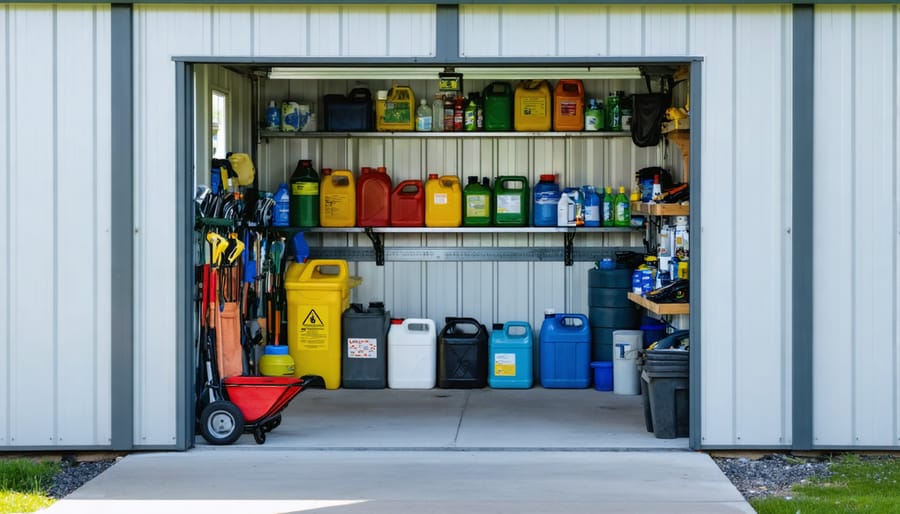Secure Your Hazardous Materials Shed: A Safety-First Storage Plan That Works

Protecting your family and property from hazardous materials requires more than just basic storage solutions – it demands a comprehensive security plan that meets both safety regulations and practical household needs. A well-designed hazardous materials security plan serves as your first line of defense against accidents, theft, and environmental contamination while ensuring peace of mind for your home environment.
Creating an effective hazardous materials security plan starts with identifying and categorizing all potentially dangerous substances in your home, from common cleaning products to garden chemicals and automotive fluids. This systematic approach allows homeowners to implement appropriate storage solutions, establish handling procedures, and maintain compliance with local safety regulations without overwhelming complexity or excessive costs.
Whether you’re storing paint thinners in your garage or pool chemicals in your backyard shed, a properly structured security plan helps safeguard your property while protecting the environment and meeting legal requirements. This guide will walk you through the essential steps to develop and maintain a hazardous materials security plan that works for your specific situation.
Legal Requirements for Hazardous Material Storage
Common Household Hazardous Materials
Most homes contain various hazardous materials that require careful storage and handling. Common household cleaning products like bleach, ammonia, and drain cleaners pose significant risks if not properly secured. In the garage or workshop, you’ll typically find flammable items such as gasoline, paint thinners, and automotive fluids. Garden chemicals, including pesticides, herbicides, and fertilizers, are another category requiring special attention.
Personal care products like nail polish remover and aerosol sprays also fall into the hazardous materials category. In basements and utility areas, you might store pool chemicals, antifreeze, or batteries. Even common items like medications and alcohol-based products need proper security measures to prevent accidents or misuse.
Remember to keep these materials in their original containers, away from heat sources, and out of reach of children and pets.
Basic Compliance Guidelines
When storing hazardous materials at home, you must follow several essential compliance guidelines to ensure safety and legal operation. First, maintain a detailed inventory of all hazardous materials, including quantities, locations, and safety data sheets. Store materials in their original containers with clear, readable labels, and keep them in a locked, well-ventilated area away from living spaces.
Establish a designated storage area that’s protected from extreme temperatures and direct sunlight. Install proper ventilation systems and ensure adequate lighting for safety. Keep incompatible materials separated and store flammable items away from potential ignition sources.
Regularly inspect containers for leaks or damage, and maintain a spill kit nearby for emergencies. Post emergency contact numbers and response procedures in visible locations. Train family members on proper handling procedures and emergency protocols.
Create and maintain documentation of your security measures, including access controls and inspection records. Review and update your security plan annually or whenever you make significant changes to your storage setup. Remember, local regulations may require specific permits or additional safety measures depending on the types and quantities of materials stored.

Essential Security Features
Access Control Systems
Securing hazardous materials begins with robust access control solutions that prevent unauthorized entry while maintaining convenient access for authorized users. For residential storage, consider installing a combination of mechanical and electronic locks. Heavy-duty deadbolts with pick-resistant cylinders provide reliable basic security, while keypad locks offer the convenience of code-based entry without physical keys.
Smart locks are becoming increasingly popular, allowing homeowners to monitor access remotely and grant temporary entry permissions when needed. For added security, consider installing door contacts and motion sensors that alert you when the storage area is accessed.
Remember to secure all potential entry points, including windows and ventilation openings, with appropriate locks or security screens. A two-factor authentication system, combining physical keys with electronic verification, provides an extra layer of protection for particularly sensitive materials.
Keep a detailed log of who has access and regularly update security codes. This not only helps track entry but also ensures compliance with safety regulations while maintaining practical usability for household members.

Ventilation and Safety Equipment
Proper ventilation is crucial when storing hazardous materials, helping prevent the buildup of dangerous fumes and maintaining safe air quality. Install exhaust fans near the ceiling, as most harmful vapors rise, and ensure fresh air intake vents are positioned at lower levels. A minimum of four air changes per hour is recommended for most storage areas.
Essential safety equipment includes fire extinguishers rated for multiple hazard classes (A, B, C), prominently displayed emergency contact information, and clearly marked exits. Install smoke detectors and chemical vapor detectors appropriate for the materials you’re storing. Keep spill containment kits readily available, including absorbent materials, protective gloves, and disposal containers.
Consider installing emergency eyewash stations and safety showers if you’re storing corrosive materials. All safety equipment should be regularly inspected and maintained according to manufacturer guidelines. Post clear instructions for equipment use and emergency procedures where they’re easily visible to anyone entering the storage area.
For optimal safety, create a maintenance schedule for all ventilation and safety equipment, checking functionality at least monthly. Keep detailed records of these inspections to ensure compliance and identify potential issues before they become problems.
Monitoring Systems
Installing a comprehensive monitoring system is crucial for safeguarding hazardous materials. Consider implementing smart security systems that include motion-activated cameras and real-time alerts sent directly to your smartphone. Position cameras to cover all entry points and storage areas, ensuring clear visibility even in low-light conditions. Modern alarm systems offer multiple protection layers, including door sensors, glass break detectors, and environmental monitors that can alert you to temperature changes or chemical leaks. For added security, consider installing backup power supplies to keep your monitoring system running during outages. Remember to test your security equipment monthly and update access codes regularly to maintain optimal protection.
Creating Your Security Plan
Risk Assessment
Begin your risk assessment by conducting a thorough inventory of all hazardous materials in your storage area. Create a detailed list noting the types, quantities, and locations of each material. Consider potential threats such as theft, vandalism, or accidental access by children or pets.
Evaluate your current security measures by checking doors, locks, windows, and lighting around storage areas. Look for vulnerable points where unauthorized access might occur. Pay special attention to areas where chemicals or flammable materials are kept, as these require extra precautions.
Next, assess your neighborhood’s security situation. Consider factors like previous incidents, proximity to public areas, and local crime rates. Document any existing security protocols and identify gaps that need addressing.
Don’t forget to evaluate natural risks like flooding or extreme temperatures that could affect your stored materials. Create an emergency response plan that includes evacuation routes and contact information for local authorities.
Review your assessment regularly, at least once every six months or after any security incidents. Update your security measures based on new risks or changing storage needs.
Emergency Response Procedures
A well-structured emergency response procedures plan is crucial for protecting your family and property when storing hazardous materials. Start by creating a detailed evacuation map with clearly marked exit routes and gathering points. Post emergency contact numbers, including local fire department, poison control, and hazmat response teams, in visible locations near storage areas.
Keep spill containment kits readily available and ensure family members know their locations and proper use. These kits should include absorbent materials, protective gear, and cleanup supplies specific to the types of materials you store. Install emergency alarms and maintain proper ventilation systems to detect and prevent dangerous situations before they escalate.
Regular family drills are essential – practice evacuation routes and emergency procedures at least twice a year. Document all incidents, no matter how minor, and use these records to improve your response plan. Remember to update your procedures whenever you add new materials or modify storage arrangements. Consider installing security cameras and motion sensors to detect unauthorized access and potential security breaches early.

Maintenance Schedule
To keep your hazardous materials secure, establish a routine maintenance schedule for all security systems and protocols. Perform weekly visual inspections of locks, storage containers, and security cameras. Monthly checks should include testing alarm systems, verifying emergency contact information, and reviewing access logs. Every quarter, conduct a thorough assessment of ventilation systems, lighting, and structural integrity of storage areas. Annually, update your security plan documentation, retrain family members or authorized users, and evaluate if any upgrades are needed based on changing needs or new safety recommendations. Keep a detailed log of all maintenance activities and any security incidents for future reference. Set calendar reminders for these checks to ensure nothing gets overlooked, and always address any issues immediately to maintain the highest level of security.
Practical Implementation Tips
Start by designating a responsible person to oversee your hazardous materials security plan – someone who will maintain records and ensure everyone follows proper procedures. Create clear labels for all storage areas and containers, using large, easy-to-read text and appropriate warning symbols.
Set up a check-in/check-out system for tracking materials, even if it’s just a simple logbook. This helps you monitor usage and quickly identify if anything goes missing. Install good lighting around storage areas and consider motion-sensor lights for added security.
Keep your security measures practical but effective. A combination padlock might be sufficient for smaller quantities, while larger amounts may require more robust locks or an electronic access system. Remember to change access codes regularly and maintain a list of authorized users.
Create laminated emergency response cards with step-by-step instructions for handling spills or security breaches. Post these in visible locations and keep copies in your emergency kit. Schedule regular training sessions with family members or employees who handle these materials.
Review and update your plan every six months, making adjustments based on any new materials you’re storing or changes in storage locations. Document all security checks and maintenance in a dedicated notebook or digital file. This creates a paper trail and helps identify patterns or potential issues before they become problems.
Finally, build relationships with local emergency responders. Invite them to familiarize themselves with your storage setup during non-emergency times.
A well-implemented hazardous materials security plan is essential for protecting your home, family, and community. By following proper storage guidelines, maintaining accurate inventory records, and regularly reviewing security measures, you can ensure the safe handling of dangerous materials while meeting all regulatory requirements. Remember to keep emergency contact information readily available and train family members on safety protocols. Regular updates to your security plan, along with periodic checks of storage containers and safety equipment, will help maintain a secure environment. Stay proactive in your approach to hazardous materials management, and don’t hesitate to consult local authorities or safety experts if you have questions. Your commitment to safety today prevents accidents tomorrow.

